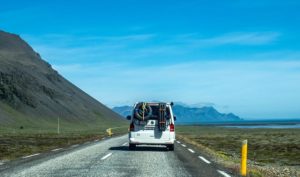Text by: Agata Ryszkowska
Icelandic domestic animals – the ordinary that’s actually pretty special
Iceland is known for its harsh climate and most tourists are aware of that. That may give an impression that the island lacks in animals and wildlife, meanwhile it’s actually not so true. The species who have been here for centuries perfectly adapted to the conditions, so let’s find out a little bit of their story.
Before Iceland was settled, the only land mammal that colonized the island on its own was the Arctic Fox. Icelanders are pretty proud of their livestock as most of the breeds haven’t been mixed with any others for centuries. The domestic animals were brought on the Viking ships and left to adapt to the difficult weather. Over time, the species have developed features that make them strong, resistant and what’s the most important – unique.
ICELANDIC HORSE
First of all – not a pony! Even though the Icelandic horse usually doesn’t get taller than 150cm, it’s still a horse. Icelanders are pretty touchy about this naming so it’s better to keep it in the back of your head. It’s said that during the settlement period only one horse could fit into a boat, so the wealthy chieftains would only bring the healthiest, strongest and smartest specimens to the island. At first the horses were used for moving around the island and selling goods. Those, who had such a mode of transport could make a decent living unlike the ones who were isolated.
Althing (Alþingi), the national parliament of Iceland, set a law in AD982 of forbidding any kind of import of foreign horses to the land. So for over 1000 years the Icelandic horses have been isolated from other breeds, developing features that let them easily survive severe winters and storms. Another interesting fact is that once an Icelandic horse leaves Iceland, it absolutely cannot come back. It’s resistant to the climate, but not so much to the potential illnesses that could infect the herds.
The horses can be seen all around Iceland all year long. During wintertime their coat grows long and shaggy, providing them so much needed warmth. They’re sturdy horses in their appearance, with thick legs, neck and bones. They vary in color from black, gray, chestnut through dun, palomino to pinto – and the hair is usually different from the coat itself. There’s over 100 names in Icelandic for their various colors and patterns. They can carry a heavy load so no worries if you ate a whole pot of lobster soup for lunch!
They’ve got another feature that make them stand out. Usually horses perform four gaits (walk, trot and canter/gallop), meanwhile Icelandic ones also have Tölt and Skeið. Tölt (or running walk) takes place between trot and canter – it’s super smooth and there’s no moment of suspension. It’s a four beat travelling gait and the feet move in the same pattern as in walk but it’s more energetic. Meanwhile Skeið (the flying pace) is said to feel like flying with speeds reaching 50km/h. Both legs on the same side touch the ground at the same time.
The Icelandic horses are stunning creatures. With their glossy coats during summer time and thick fur in the winter, it’s hard not to get close to them. They’re brave, curious and gentle so that makes a perfect companionship. It’s not common for them to get scared easily, so if you happen to stop on a roadside to pet them, most likely a bunch of them will come over for a little bit of scratching on their necks (don’t feed them though!). With their endless energy, alert mind and friendly approach, both adults and children will be delighted to go horseback riding. You absolutely don’t need to worry if you have no experience! There’s a great deal of tours that you can choose from: half-day ones, day tours, multiple day tours or combined ones that include for example whale watching or Northern Lights hunting. The choice is yours!
ICELANDIC SHEEP
Just like the Icelandic horse, the sheep were also brought by Norsemen to the country during the settlement era. It’s a pure breed that’s not been mixed, although there were unsuccessful attempts to do so. Sheep have kept Icelanders’ bellies full and bodies warm for centuries. There’s nearly 800 000 sheep in the country during the summer time, so the amount doubles the population of Iceland. They’re fast, alert individuals that are not very docile.
The Icelandic sheep is not particularly tall, it’s rather on a broader side. Both ewe (female) and ram (male) are usually horned, have short legs and the face and the legs are free of wool. Their wool on the other hand is a very precious gem for the Icelandic community. It comes in various colors and it actually consists of two separate layers. A short and soft undercoat and longer, harsher outer-layer. It’s been used for knitting and manufacturing for ages and it’s a shame for an Icelander not to own a lopapeysa, which stands for an extremely warm yet breathable, waterproof sweater or jumper. It’s knitted with a specific pattern therefore it’s the most perfect, ultimate souvenir from Iceland that’s going to last for years.
If you happen to drive around Iceland during summer time, always keep in the back of your head that a sheep might suddenly pop up on the road. They roam freely during the warm months so it’s absolutely normal to meet them in the most bizarre places. If you’d like to meet little baby lambs, it’s best to come to Iceland at the turn of May and June. The sheep are gathered back around October and such event is called Réttir (roundup). It’s one of the oldest traditions and families, friends and volunteers drink, dance and sing to celebrate this special time of the year. Anyone can participate! The legends say that sometimes, but not too often, it’s not possible to gather all of the sheep – the next summer the farmers are surprised to have found the missing sheep with little baby lambs.
Unfortunately, the lambs don’t live long lives. They’re usually slaughtered by the end of summer, when they’re 4-5 months old. 80% of the income comes from their meat. It’s a traditional meat in Iceland and most of the restaurants offer various dishes contain lamb, such as kjötsúpa (lamb soup) or a little bit more controversial one – svið, which consists of lamb’s head cut in half. It’s said that their meat is very flavorsome due to free grazing and chewing on Icelandic thyme.
ICELANDIC SHEEPDOG
Just like the horses and the sheep, Icelandic sheepdogs (Íslenskur fjárhundur) were brought to Iceland many centuries ago. Their breed is pure and they’re a tad smaller than their cousins from abroad, just like the other animals living in Iceland. There’s a strict policy in regards to bringing cats and dogs from abroad – most of the animals in Iceland due to the isolation aren’t immune to most of the foreign illnesses. The sheepdogs were near extinction – by 1935 their number was reduced to just 35 individuals due to disease. Fortunately, it was possible to rebuild the population and nowadays there’s around 5 000 od them living on the island.
One of the most interesting facts is that in the Middle Ages it was not an uncommon action to export the Icelandic sheepdogs, especially to the UK for wealthy families and farmers in need. In 1869 a law came to life in Iceland about dog ownership, and two years later a high dog tax was established. The reason of such action was that the dogs would carry eggs and bandorms that caused echinococcosis disease in humans and sheep.
Like most of the sheepdogs, they’re highly energetic, intelligent with herding instinct. Thanks to the latter they also make a great guard dog without being aggressive. They mostly protect sheep, horses and cattle, although they also make a reliable help in avalanche rescue. They’re friendly and cheerful, so that makes them a perfect company for active families.
When it comes to their appearance, they look like a mix of chow and husky, with a tiny bit of Norwegian buhund, shetland sheepdog and corgi. They’ve got a cute curled tail and a thick, double coat that’s highly waterproof that makes it possible for them to easily survive severe conditions. The fur is usually tan or in yellowish color and their mood is expressed with prickled, lively ears. They’re fast learners and loyal companion!
ICELANDIC CATTLE
Icelandic cattle has its origins in Norway, from where it was brought to Iceland around 10th century. Females as well as males are usually smaller than their foreign cousins, which used to be an advantage due to limited space in barns and houses and the lack of hay back in the old days. Nowadays farmers also need to be watchful about the amount of stocked hay. The vegetation period in Iceland is not that long so if winter decides to stay for a little longer than usual, it could mean not having enough food to sustain the sheep, horses or cattle.
The cattle hasn’t been cross-bred yet, although there could be some voices heard that it might me done in the future. Due to their smaller size the cows don’t give as much milk as for example the ones from Sweden. Even though Icelanders don’t feel as connected to cattle as to the horses, there was still some resistance in making this idea come to life. The world renewed Icelandic product that’s made of the cows’ milk is skyr – it’s technically a fresh sour milk cheese, however it’s eaten like a yogurt. It’s high in protein and it’s an important part of Icelandic heritage. It could be eaten plain but there are also flavored versions, for example vanilla or strawberry ones.
One of the most special features that cattle can be proud of is how colorful they are! Each cow and bull has its special pattern and the farmers are pretty proud of it. The cattle usually don’t have horns. An interesting fact says that they’re kept inside for nearly 8 months but when the spring finally arrives and they’re free to roam in the field, the robot milking gives them an opportunity to choose when they would like to be milked. They also decide whether they would like to stay inside or outside.
If you happen to be in Iceland on June 24 which happens to be a holiday in Iceland called Jónsmessa (Midsummer Night), odd things can take place. It’s said that the seals become human, it’s beneficial for your health to roll naked in the dew-covered grass and the cows gain the power of speech. So lend an ear and don’t forget to share with us the secrets you heard!

















